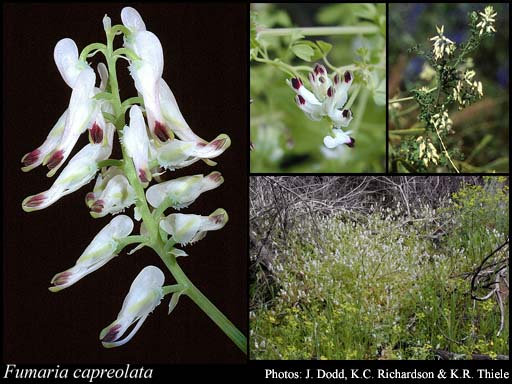- Reference
- Sp.Pl. [Linnaeus] 2:701 (1753)
- Conservation Code
- Not threatened
- Naturalised Status
- Alien to Western Australia
- Name Status
- Current
Climbing or scrambling annual, herb, 0.1-1(-3) m high. Fl. white & red/brown, Aug to Nov. Common on wasteland, road verges.

Distribution
- IBRA Regions
- Avon Wheatbelt, Esperance Plains, Geraldton Sandplains, Jarrah Forest, Mallee, Swan Coastal Plain, Warren.
- IBRA Subregions
- Dandaragan Plateau, Geraldton Hills, Katanning, Merredin, Northern Jarrah Forest, Perth, Recherche, Southern Jarrah Forest, Warren, Western Mallee.
- IMCRA Regions
- Leeuwin-Naturaliste.
- Local Government Areas (LGAs)
- Albany, Armadale, Augusta Margaret River, Bayswater, Beverley, Bridgetown-Greenbushes, Broomehill-Tambellup, Bunbury, Busselton, Cambridge, Canning, Capel, Chittering, Claremont, Cockburn, Cottesloe, Dandaragan, Dardanup, Denmark, Esperance, Fremantle, Gingin, Greater Geraldton, Kalamunda, Kwinana, Lake Grace, Manjimup, Melville, Moora, Mundaring, Nannup, Narrogin, Nedlands, Northam, Perth, Rockingham, Serpentine-Jarrahdale, South Perth, Stirling, Swan, Victoria Plains, Vincent, Wagin, Wanneroo, West Arthur, Wickepin, Wongan-Ballidu, Woodanilling.
Management Notes (for the Swan NRM Region)
Alternative Names. Climbing Fumitory, Whiteflower Fumitory.
General Biology. Growth form. Herb. Life form. Annual. Reproduction. Seed. Dispersal. Contaminated seed, soil movement. Toxicity. Suspected of poisoning stock. Seedbank persistence. 20 years.
Notes. Colonises degraded sites. May hybridise with Fumaria muralis. Can be difficult to control due to a strongly persistent soil seed bank. Herbicide control can be unpredictable and variable, with tolerance and resistance varying among species of Fumaria. Potential biological control agents were assessed after one species Fumaria densiflora developed populations with herbicide resistance.
Additional information. Origin. Northern Africa, temperate Asia, Europe Macronesia, northern Africa, Temperate and western Asia, Europe. Similar exotic species. Fumaria muralis.
Suggested method of management and control. Spray metsulfuron methyl at 0.1 g/15 L (2.5 g/ha) + wetting agent or glyphosate 0.5%. Read the manufacturers' labels and material safety data sheets before using herbicides. For further information consult the Australian Pesticides and Veterinary Medicines Authority to determine the status of permits for your situation or state.
Management Calendar
| Calendar Type | Jan | Feb | Mar | Apr | May | Jun | Jul | Aug | Sep | Oct | Nov | Dec | Comments |
|---|---|---|---|---|---|---|---|---|---|---|---|---|---|
| Germination | Y | Y | Y | Y | Y | Y | |||||||
| Active Growth | Y | Y | Y | Y | Y | Y | |||||||
| Flowering | O | Y | Y | Y | Y | ||||||||
| Fruiting | U | U | U | ||||||||||
| Optimum Treatment | Y | Y | Y |
Legend: Y = Yes, regularly, O = Occasionally, U = Uncertain, referred by others but not confirmed.
References
- Brown, K. & Brooks, K. (2002) Bushland Weeds: A Practical Guide to their Management. Environmental Weeds Action Network, Greenwood.
- Hussey, B.M.J., Keighery, G.J., Dodd, J., Lloyd, S.G. & Cousens, R.D. (2007) Western Weeds. A guide to the weeds of Western Australia. 2nd Edition. The Plant Protection Society of Western Australia, Victoria Park.
- Jourdan, M., Vitou, J., Thomann, T., Maxwell, A. & Scott, J.K. (2008) Potential biological control agents for fumitory (Fumaria spp.) in Australia. In Proceedings of the XII International Symposium on Biological Control of Weeds, La Grande Motte, France, 22-27 April, 2007. 2008. 160-164. 21 ref. Publisher CAB International.
- Moore, C.B. & Moore, J.H. (2002) Herbiguide, the pesticide expert on a disk. Herbiguide, PO Box 44 Albany, Western Australia, 6330.
- USDA, ARS, National Genetic Resources Program (2009) Germplasm Resources Information Network - (GRIN). National Germplasm Resources Laboratory, Beltsville, Maryland. URL: https://npgsweb.ars-grin.gov/gringlobal/taxon/taxonomysimple.aspx - Accessed October 2009.